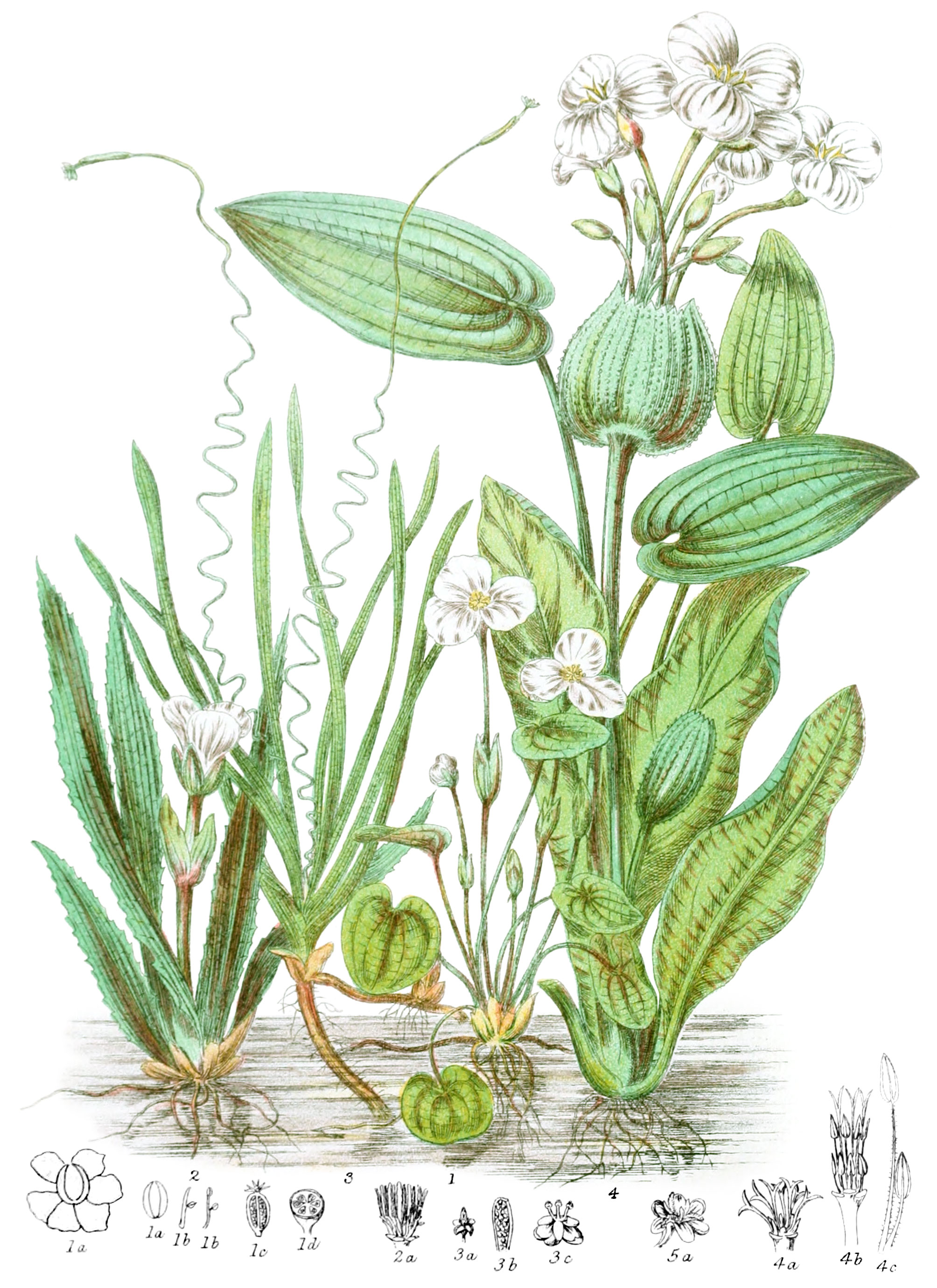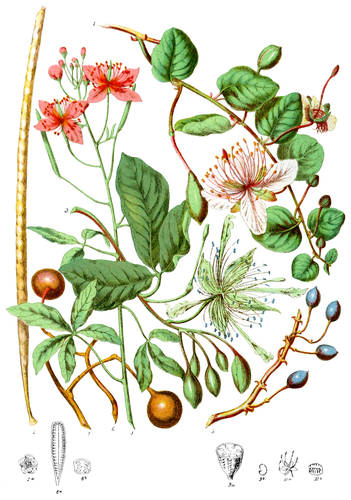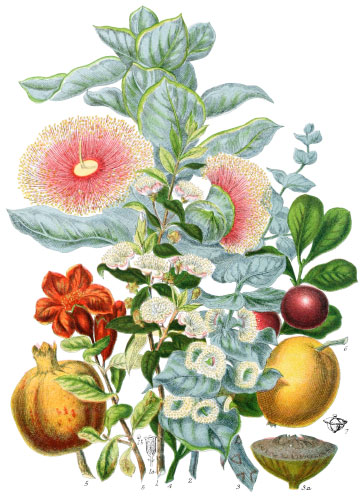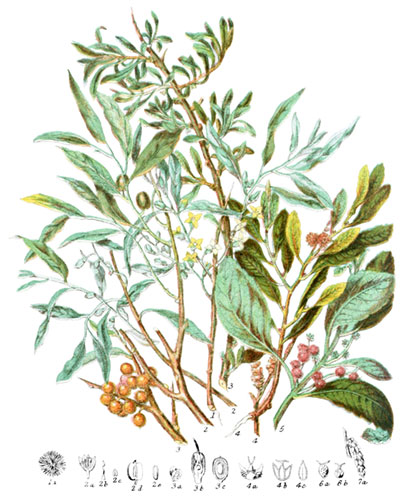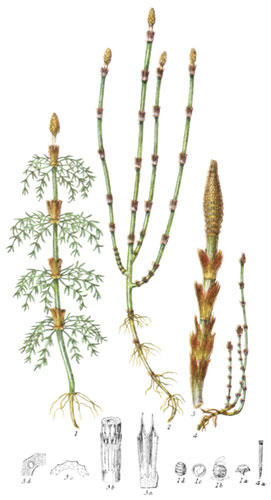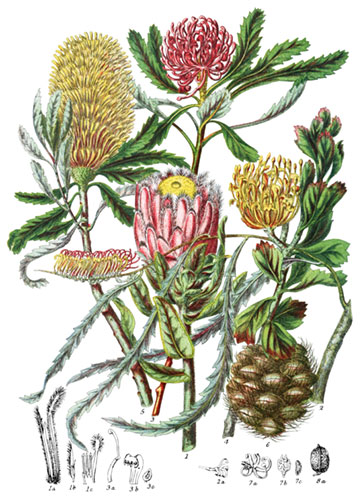Key characteristics
Floating water-plants, the leaves have parallel veins, and are sometime spiny. The flowers are enclosed in a spathe. The stamens and pistil sometimes in different flowers; the calyx is composed of three sepals; the petals are three, occasionally wanting. The stamens are of definite or indefinite number; in Hydrocharis some are beaked. The ovary is adherent, composed of several carpels, one, six, or eight, or nine-celled; the stigmas are from three to six. The fruit is dry or succulent, not gaping, with one or more cells. The seeds are numerous, and contain no albumen.
In many points of structure this Tribe has affinity with Alismaceæ; the spathe forms a connecting link with Araceæ.
Some of these plants are wholesome as food.
Select plants in this order
Not all plants listed are illustrated and not all plants illustrated are listed.
- Hydrocharis was named from the Greek, on account of its being considered one of the prettiest of European water-plants. It spreads far with long runners, from the points of which proceed roods, penetrating the mud, and young buds, enclosed in two scales, afterwards becoming separate plants.
- In the watery places of the Isle of Ely, the Frog-bit (1) was formerly very abundant, but is now less frequent. The leaves are mucilaginous, and slightly astringent: they have large stomas or pores on their surface. Some few characters prevail generally in aquatic plants: here a resemblance may be traced from the form of the leaves to those of small water-lilies: in this instance it affords a proof of the countless links which are found amongst plants, even where the principal structure may be different. From similarity of aspect, the Frog-bit was by old writers called lesser water-lily; and modern botanists perceive the analogy, although the one plant belongs to the great division of monocotyledons, the water-lilies to the dicotyledons.
- Stratiotes (2) derived its name of water-soldier, from its stiff sword-shaped leaves, and upright manner of growth. Dioscorides describes it under the Greek name, which well explains the close ranges of its leaves, like an army. The name of Water-alow is also appropriate. The flowering stem rises to the surface when in blossom, and until the seed ripens, when it again becomes immersed, and sends out fresh runners, prepared to bear new plants the following summer. As is usual with water-plants when once located in favourable situation, it increases rapidly. Since the extensive draining of the fens in east of England, Stratiotes is becoming more rare in those districts.
- Vallisneria spiralis (3) was named in memory of a Professor at Pauda, physician to Charles VI. It is one of the most remarkable plants of this tribe, being singularly adapted to the situations where it grows. It is chiefly found in the Rhone, whose waters rise with considerable rapidity from sudden floods. The stalks of the pistil flowers are long and spiral, and are thus enabled to rise and fall according to the level of the river. The stamen flowers are on short stalks, but detach themselves when fully grown, and float on the surface of the water, scattering the pollen: when the seeds are ripened, the spiral stalk again contracts, and carries down the capsule to bury its seeds in the mud. This process is similar to that which occurs in the spiral stalk of Cyclamen under different circumstances. Although the southern course of the Rhone is the principal habitation of Vallisneria, it grows also in the Languedoc Canal, and in the north of Italy. Some rivers of North America, of India, and of Australia, likewise shelter this curious plant.
- V. alternifolia grows near Madras and Calcutta, and in Silhet; V. minor has been discovered in the neighbourhood of Allahabad.
- Boottia (4) was first found by Dr. Wallich, on the banks of the Irawaddi, flowering profuesely; the leaves and stalks are of a mucilaginous nature, and afford food to the Burmese, for which it is collected and sold in the markets of Ava.
- The leaves and fruit of Enhalus are also eatable, and its fibres are said to be capable of being woven.
- Hydrilla verticillata is used in India to cover sugar during the process of refining; but the useful properties of these plants are few.
- Anacharis (5)* has been of late years introduced from North America, and has rapidly covered canals and small rivers in Cambridgeshire, to the great impediment of boats.
Locations
This Tribe inhabits fresh water in Europe, Asia, and North America. Two species of Vallisneria have been discovered in Australia.
Legend
- Hydrocharis Morsus-ranæ, Frog-bit. Ponds, Britain.
- Stomas, magnified.
- Stamens.
- Stratiotes aloides, Water-Soldier, or Water-Aloe. Ponds, Britain.
- Stamens.
- Vallisneria spiralis, Spiral-stalked Vallisneria. Rhone.
- Stamen flowers.
- Section of Ovary.
- Stamen Flower magnified.
- Boottia cordata, Heart-leaved Bootia. Ava.
- Pistils.
- Stamens.
- Stamens, magnified.
-
- Anacharis alsinastrum. Flower magnified.
- *5 was mentioned in the original description but only 5a was illustrated.
- †1c and 1d were not named in the original description.
Explore more
Posters
Decorate your walls with colorful detailed posters based on Elizabeth Twining’s beautiful two-volume set from 1868.
Puzzles
Challenge yourself or someone else to assemble a puzzle of all 160 botanical illustrations.
